If Ondo Chain develops smoothly, Ondo will be able to enjoy the valuation level of public chains, making a market cap of several billion dollars and a fully diluted valuation of over 10 billion seem less exaggerated.
Author: Alex, Mint Ventures
Introduction: The Necessity of Focusing on the RWA Track at This Moment
In this round of the crypto cycle, which has been lacking in innovation, we have not seen new tracks like the previous round's DeFi, NFTs, or even GameFi. Meme speculation has become the main focus of market trading. However, with the mass production of projects, the accelerating pace of liquidity extraction, and the exhaustion of themes, the meme market has also entered a destined period of recession. Many AI projects, as new themes in this round, have yet to find an appropriate product fit between Crypto and AI, resulting in weak business logic for the track, making it difficult to attract long-term industrial investment and long-term capital.
The complete failure of commercialization exploration in the Web3 track, along with the lack of solid industrial logic in investment narratives, is the main reason why most crypto assets, aside from BTC, have entered a "bear market" ahead of time. The recession in the application track has also directly led to the continuous decline in the valuation of public chain platforms that support applications, causing the exchange rate of public chain assets represented by ETH to continue to fall against BTC.
Meanwhile, BTC has benefited from multi-dimensional improvements in its fundamentals (opening of compliant investment channels, government reserves, inclusion in the balance sheets of listed companies and sovereign funds, a regulatory shift towards friendliness, etc.). After experiencing a few months of mid-term correction, it has now returned to near new high positions, accumulating considerable unrealized profits.
There remains a demand for this portion of funds to realize some profits and seek out altcoins with better elasticity for investment.
The question is, what to buy?
In comparison with other crypto tracks, RWA may be one of the more noteworthy categories to focus on.
In my article “US Stocks on the Chain and STO: An Unseen Narrative”, I explained the underlying thoughts: From a business logic perspective, the value proposition of tokenizing US stocks and more RWA assets is clear, with demand from both supply and demand sides being relatively explicit. Additionally, the improved regulatory environment represented by the United States provides an opportunity for the explosion of this track, and powerful traditional financial institutions are eager to try it out.
Based on this, I have recently conducted research on numerous RWA projects, and Ondo, as a representative project among them, is worth a detailed analysis.
In this report, I will analyze Ondo's current business status, team background, competitive situation, challenges and risks, and compare its current valuation level with other projects in the same track.
PS: This article reflects my stage-based thoughts as of publication, which may change in the future. The views expressed are highly subjective and may contain errors in facts, data, or reasoning logic. All opinions in this article are not investment advice, and I welcome criticism and further discussion from peers and readers.
1. Business Status
1.1 Product Matrix
Ondo Finance is an institutional-level platform focused on tokenizing traditional financial assets (Real-World Assets, RWA) and introducing them to the blockchain. It is currently the most well-known and comprehensive project among RWA projects that have issued tokens.
Ondo's products include tokenized funds, interest-bearing stablecoins, lending platforms, tokenized asset issuance protocols, tokenized asset trading platforms, and its own compliant blockchain, covering the entire process of RWA from issuance, custody to trading circulation.
We can also categorize its products into asset types, protocol types, and infrastructure types.
Next, let's take a look at Ondo's main products.
1.1.1 Asset Products
OUSG (Ondo Short-Term US Government Bond Fund)
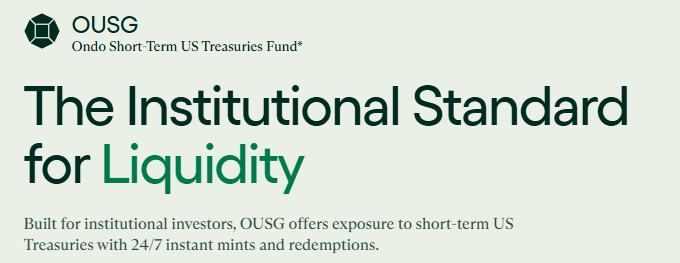
A token backed by US Treasury bonds, issued to qualified investors (Qualified Purchasers) with strict KYC/qualified investor certification requirements. By purchasing OUSG, investors effectively hold a share of a portfolio of short-term US Treasury assets managed by professional fund managers. The intrinsic value of OUSG tokens will increase as the fund's net asset value rises, equivalent to daily automatic reinvestment of interest income. The underlying assets of OUSG include not only the BlackRock BUIDL US Treasury Fund but also shares of US Treasury bonds issued by Franklin Templeton (FOBXX), Wellington, WisdomTree, Fidelity, and others as reserve assets.
OUSG's Profit Model
OUSG charges institutional clients a management fee of 0.15% (currently not charged, to be implemented starting July 1, 2025) and fund expenses (also 0.15%, currently being charged). Its actual returns are generated from the interest on the underlying US Treasury bonds minus these fees.
USDY (US Dollar Yield)
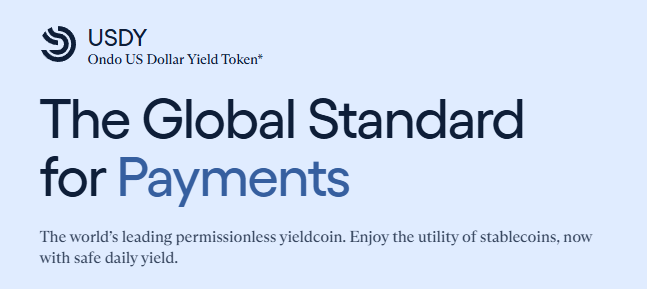
An interest-bearing US dollar stablecoin. USDY is issued to non-US individual and institutional users, supported by interest from short-term US Treasury bonds and bank deposits. The base price of USDY is 1 dollar, but interest is calculated daily and added to the token's value, allowing holders to automatically earn returns. Therefore, users do not need to stake or lock up their tokens; simply holding USDY allows them to accumulate returns daily. The yield calculation for USDY typically references the risk-free rate (SOFR) minus a 0.5% fee.
USDY's Profit Model
Ondo sets the annualized yield for USDY each month (e.g., 4.25% for a certain month) and allocates most of the base yield to token holders, retaining about 0.5 percentage points as a management fee.
Additionally, both OUSG and USDY can be converted into stable value tokens with rebase functionality, namely rOUSG and rUSDY. Their value will remain unchanged, but the number of tokens will increase with the growth of returns, similar to Lido's stETH mechanism.
Differentiated Positioning of OUSG and USDY
Although OUSG and USDY appear very similar in definition, as both direct funds towards high-quality cash equivalents like short-term US Treasury bonds, they still differ in several aspects and have different positioning:
Asset Composition Differences: OUSG indirectly invests in US Treasury bonds by holding shares of multiple regulated government bond funds (such as the BlackRock BUIDL Fund and WisdomTree's WTGXX), with a diverse portfolio entirely composed of government-related securities. In contrast, USDY adopts a direct holding strategy, with most assets being a combination of bank deposits and short-term Treasury bonds. USDY does not invest in any fund products, and the proportion of bank demand deposits is significantly higher.
Returns and Risks: The yield levels of both closely follow the risk-free rate (approximately 4-5% annualized), with little difference. However, USDY has slightly higher yield stability due to holding some bank deposits, with its net asset value being almost unaffected by interest rate fluctuations, while a 3% over-collateralization adds a cushion against risks. Correspondingly, USDY introduces a certain level of bank credit risk (though efforts have been made to mitigate it), while OUSG is essentially fully backed by US government credit (with purer credit quality). Therefore, while USDY bears minimal bank risk, it achieves yield stability and risk isolation through asset structure design, whereas OUSG directly reflects the interest rates of the Treasury bond market, with risks stemming entirely from fluctuations in Treasury bond rates.
Liquidity and Redemption Mechanism: OUSG is aimed at qualified investors, providing the convenience of instant redemption and on-chain settlement, but secondary market transfers are restricted, requiring circulation in a limited environment where only KYC-approved institutional addresses can hold it. USDY, on the other hand, becomes a freely tradable interest-bearing stablecoin after an initial lock-up period (40 days), allowing it to circulate freely on-chain, which enhances its liquidity and broad availability. However, due to the 40-day waiting period, USDY's initial liquidity is not as immediate as OUSG. In terms of redemption, OUSG supports direct exchange for USDC, while USDY's official redemption requires fiat currency withdrawal and has a minimum amount requirement, so generally, USDY holders will liquidate through secondary market trading.
Face Value: The base face value of OUSG is 100 dollars, while the base face value of USDY is 1 dollar.
We can simply understand that USDY focuses more on open circulation and caters to retail demand, positioning itself as a stablecoin; while OUSG emphasizes immediate liquidity in a closed environment, catering to institutional demand, positioning itself as a fund share.
1.1.2 Protocol Products
Flux Lending Platform
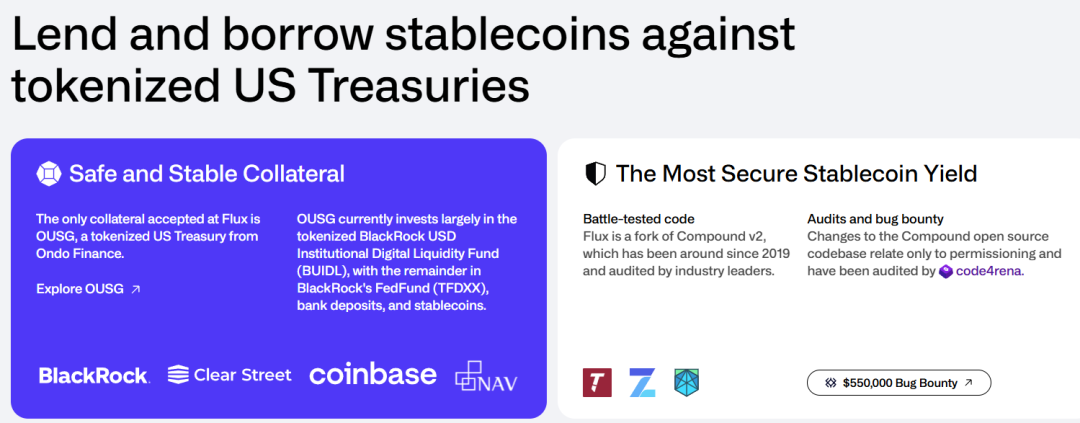
Flux Finance is a decentralized lending protocol developed based on the Compound V2 asset pool model. It allows users to use high-quality RWA assets (currently only supporting OUSG) as collateral to borrow stablecoins, as well as lend idle stablecoins to earn interest. Flux currently supports deposits and loans of stablecoins such as USDC, DAI, USDT, and FRAX. It also implements permission controls for restricted assets like OUSG (only whitelisted addresses can be used as collateral), balancing compliance. Flux is governed by Ondo DAO, where ONDO token holders control parameters and asset lists through governance. The emergence of Flux allows users holding OUSG to pledge for liquidity.
With only OUSG as the available collateral asset, Flux is not very prominent, and its business volume of several tens of millions of dollars in loans is not large. However, as more RWA assets are introduced to the chain in the future, Flux will become a key component of the Ondo ecosystem, providing lending liquidity for RWA assets within the ecosystem.
Ondo Global Markets (abbreviated as GM)

In February 2025, Ondo officially announced the design of the GM platform at the first Ondo Summit held in New York. This platform is part of Ondo's plan for traditional asset tokenization, aiming to bring thousands of publicly traded securities (stocks, bonds, ETFs, etc.) onto the blockchain. Ondo refers to the vision of this product as "Wall Street 2.0." Ondo GM is expected to be open to investors outside the United States, with all issued GM tokens backed 1:1 by real securities, allowing for free transfer like stablecoins and application in DeFi, while incorporating compliance permission controls at the issuance and redemption levels. Ondo pointed out that the current traditional investment environment suffers from high costs, limited channels, and fragmented liquidity, and GM aims to achieve lower costs, 24/7 trading, and instant settlement through blockchain technology. For example, investors will be able to conveniently obtain tokenized versions of US stocks/funds like Apple, Tesla, and the S&P 500 ETF, and trade freely in non-US markets or participate in on-chain financial services. The GM platform will also support token holders in choosing to participate in securities lending to earn additional income.
However, Ondo Global Markets has not yet officially launched. Its business webpage only vaguely states that it "is expected to be released later this year." The business is likely still preparing in various aspects such as product development and compliance. Clear compliance guidelines from US regulatory agencies regarding asset tokenization, as well as explicit related legislation, will be important prerequisites for the smooth operation of this product. Additionally, Ondo Global Markets will operate on Ondo Chain, which will be detailed below.
Nexus Asset Issuance Protocol
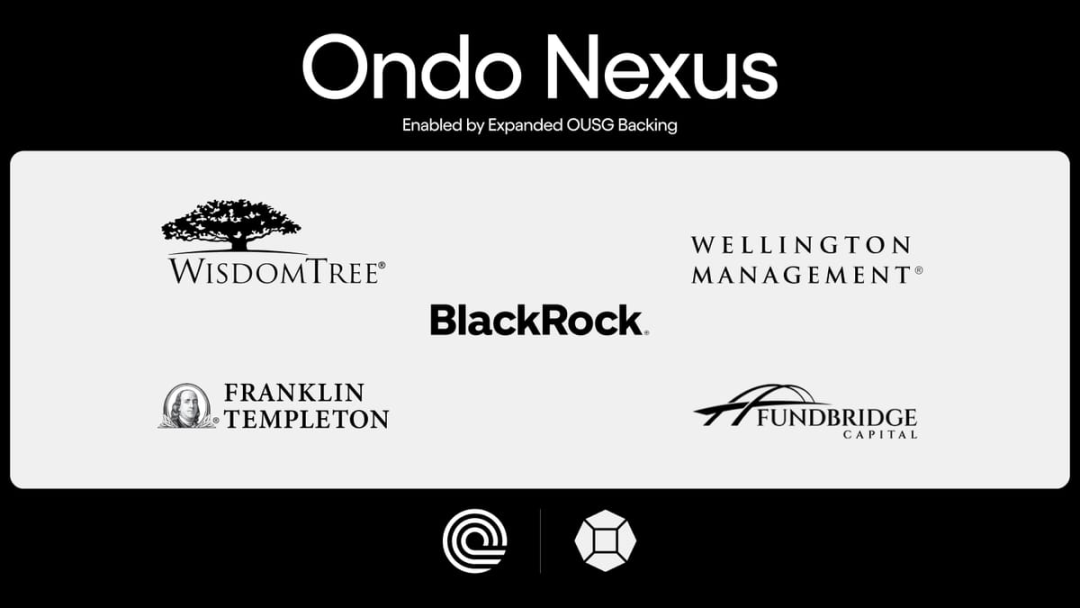
Ondo Nexus is a new technical solution launched in February 2025, aimed at providing instant liquidity for US Treasury bond tokens issued by third parties. In simple terms, Nexus utilizes the instant mint-and-burn capability of OUSG to act as a common liquidity layer between different issuers. Ondo has expanded the range of eligible collateral for OUSG to include US Treasury bond tokens from companies like Franklin Templeton, WisdomTree, and Wellington. The income certificates issued by these partner institutions (such as Franklin's FOBXX fund token) can be accepted by Ondo and exchanged for OUSG, thereby achieving shared liquidity between various products and stablecoins. Through Nexus, an investor holding a third-party institution's US Treasury bond token can sell it to Ondo for USDC or other stablecoins at any time, 24/7, while Ondo incorporates that token into its asset pool as support and mints an equivalent amount of OUSG. This provides the entire market with an "instant redemption" mechanism, breaking the limitation that traditional funds can only redeem during limited time windows on business days. The launch of Nexus also strengthens Ondo's partnerships with asset management giants like BlackRock and Franklin.
1.1.3 Infrastructure Products
Ondo Chain: A Compliance-Focused Permissioned L1
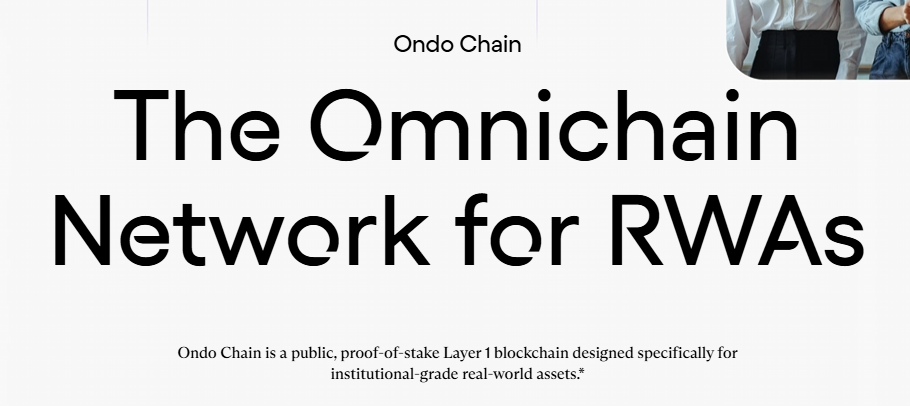
In February 2025, Ondo announced the launch of its own semi-permissioned blockchain, Ondo Chain, specifically designed for institutional-level RWA issuance and trading. Ondo Chain adopts a Proof of Stake (PoS) consensus mechanism, but the assets that validators can stake are not limited to crypto assets; they can also include highly liquid real-world assets to reduce the impact of crypto market volatility on network security. The validating nodes will be comprised of well-known financial institutions that have been granted permission (intended advisors include Franklin Templeton, Wellington, WisdomTree, Google Cloud, Dutch Bank, Aon, McKinsey, and other large traditional institutions).
The chain's features combine the transparency of public chains with the compliance security of permissioned chains: open access and development on-chain, but with controlled validation layers to prevent MEV attacks and meet regulatory requirements. Additionally, Ondo Chain natively supports key financial functions (such as dividend distribution, stock splits, etc.) and provides on-chain proof of reserves, with validators conducting regular audits to ensure that each token is backed by sufficient physical assets. Ondo Chain will also include a cross-chain bridge based on a decentralized validation network. The term "open" refers to allowing anyone to issue tokens, develop applications, or access the network as users or investors. At the same time, user identity verification and permissions will be core functions of Ondo Chain, allowing asset issuers and application developers to implement permission management and transfer restrictions at the appropriate contract level. This means that while users can freely access the network, developers can stipulate at the contract level which users on the network can access the protocols and assets they deploy.
The goal of the chain is to serve as the underlying architecture for the future "Wall Street 2.0," enabling institutions to conduct operations on-chain, including prime brokerage and cross-collateralized lending, achieving seamless integration of traditional finance and DeFi. Ondo Chain is expected to undergo testing and launch in 2025, and it is reported that it is currently collaborating with institutions like PayPal, Morgan Stanley, and BlackRock to design network details.
In summary, Ondo Finance has initially built a comprehensive matrix covering asset issuance, liquidity management, and infrastructure. Its product line ranges from underlying assets (US Treasury bonds, bank deposits, publicly traded securities) to on-chain protocols and infrastructure (lending, cross-chain bridges, dedicated chains), working in synergy and delivering business to one another.
1.2 Business Data
Although Ondo Finance has a wide range of product layouts, there are currently not many products that have actually launched. The asset products are OUSG and USDY, while the protocol product is the lending product Flux.
OUSG Business Data
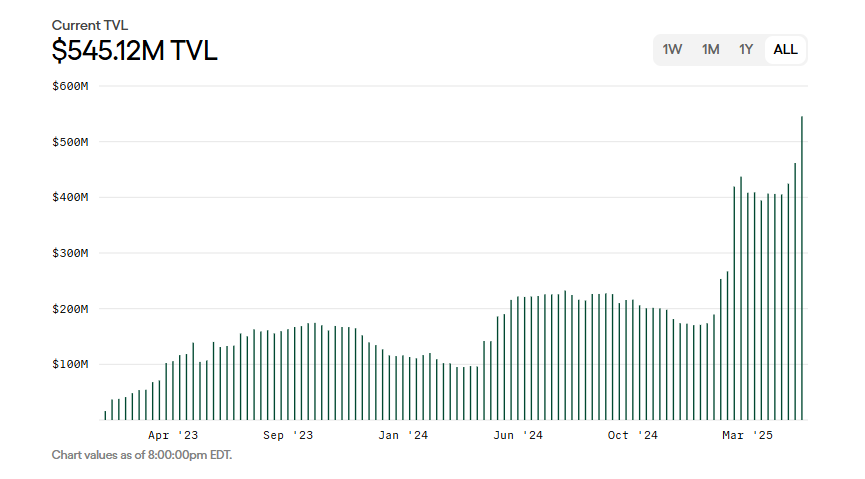
Data Source: Ondo Official Website
Currently, the total asset scale of OUSG is $545 million. Since its issuance in 2023, its scale has experienced three rapid growth phases, with the fastest growth occurring from February of this year to now, increasing from less than $200 million to over $500 million.
OUSG is supplied on three blockchains: Ethereum, Polygon, and Solana, but the vast majority of issuance occurs on Ethereum, with very small scales on the other two chains.
Observing the address data on Ethereum, there are only 57 addresses holding OUSG, and the top 10 addresses account for over 90% of the total asset issuance, which aligns with the fact that OUSG is only open to compliant institutions.
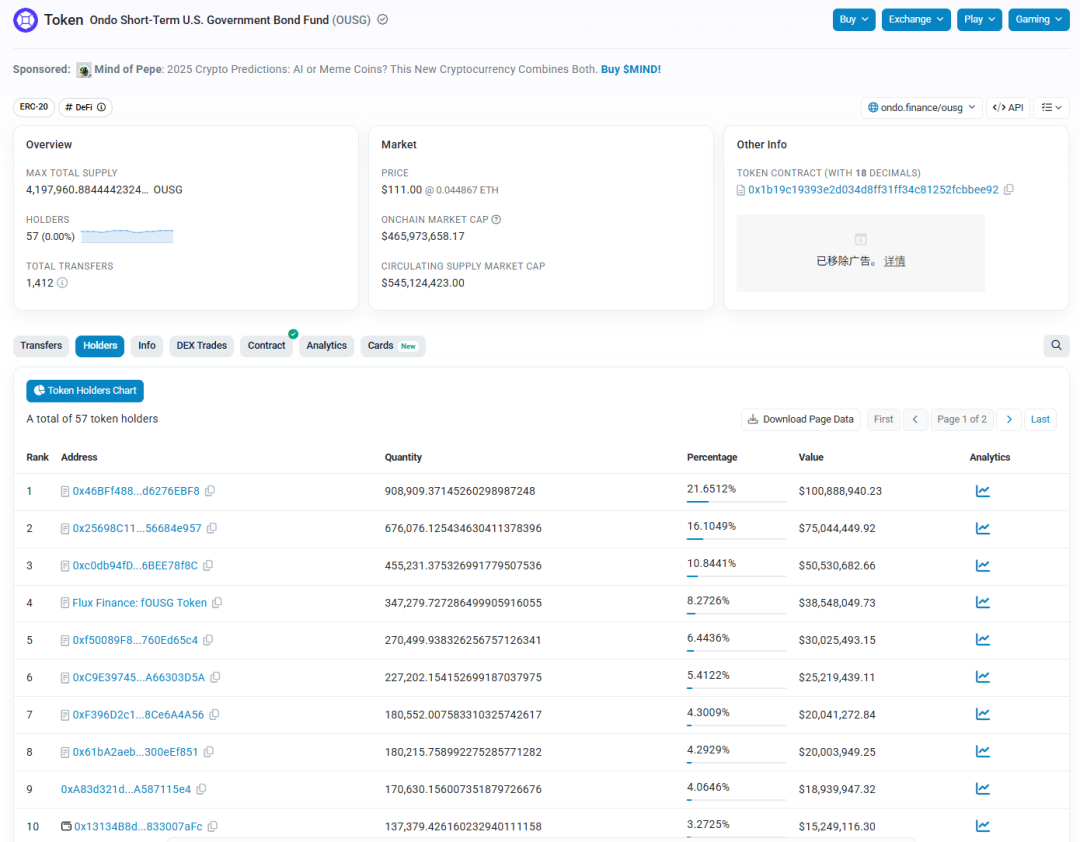
Data Source: etherscan
USDY Business Data
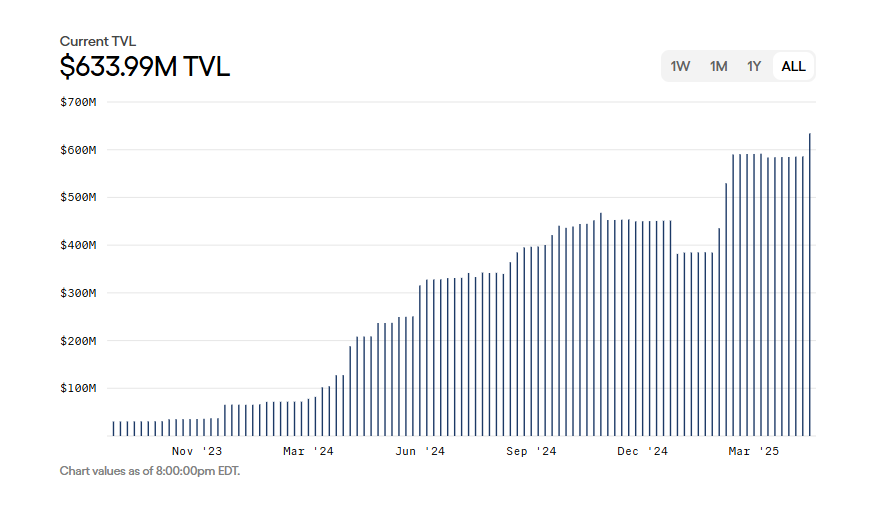
Data Source: Ondo Official Website
Currently, the total asset scale of USDY is $634 million, supporting eight blockchains including Ethereum, Mantle, Solana, Sui, Aptos, Noble, Arbitrum, and Plume.
Ethereum is also the main battlefield for USDY issuance, with its issuance scale on Ethereum exceeding half, with a market value of approximately $330 million. The number of holding addresses is also not large, with only 316; Solana follows closely behind, with an issuance market value of approximately $177 million and a holding address count of 6,329, indicating a higher retail user adoption rate.
Flux Business Data
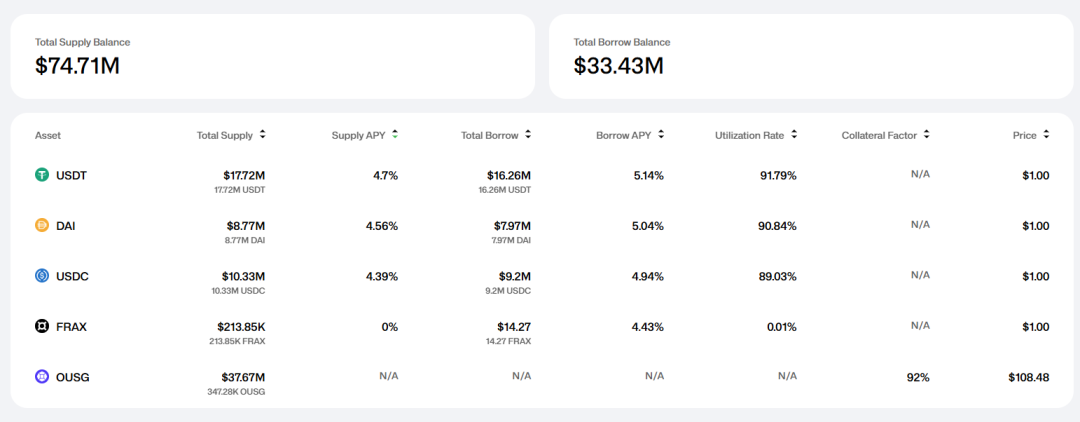
Data Source: Flux Official Website
Since Flux currently only supports OUSG as collateral, its business scale is not high, with total deposits amounting to $74 million and borrowed funds of $33.43 million. The future growth of Flux still relies on the Ondo ecosystem's ability to introduce more RWA assets.
1.3 Team Background
As a track that strongly emphasizes compliance and integrates DeFi with traditional finance, whether the project team possesses rich business resources from traditional financial institutions, has established smooth communication channels with government regulatory departments, and has deep industry experience in financial compliance are important references for judging whether the project can develop smoothly in the future.
Key Members' Professional Background
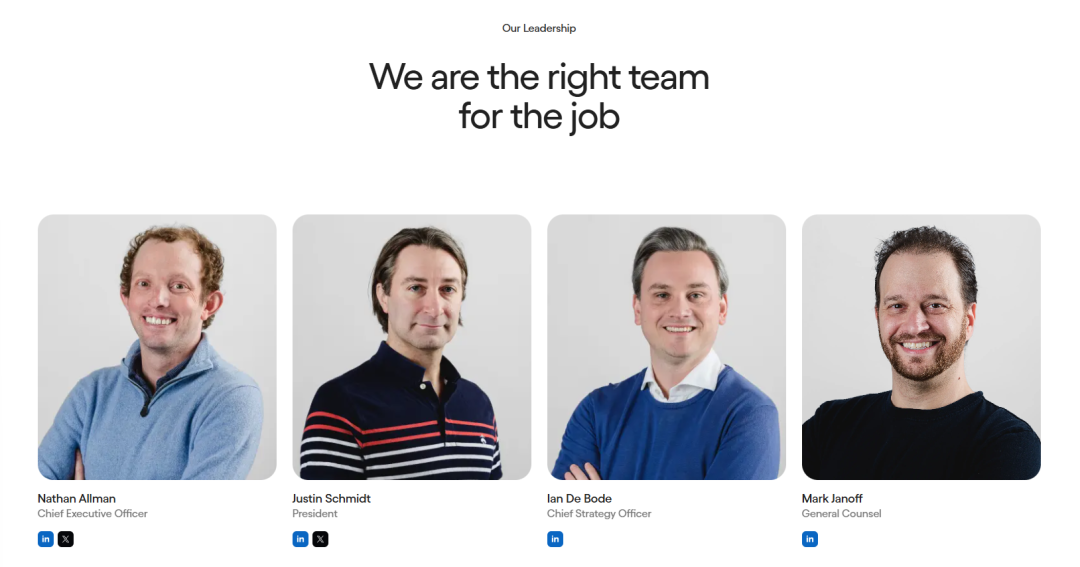
Source: Ondo Official Website
The founding and executive team of Ondo Finance mainly comes from large financial institutions on Wall Street and well-known consulting firms, with several members from Goldman Sachs' digital asset business department, and all core team members are fully identified.
Among them, co-founder Nathan Allman previously worked in Goldman Sachs' digital asset department. President and COO Justin Schmidt served as the head of Goldman Sachs' digital asset markets department and was one of the founding members of Goldman Sachs' digital asset team. Chief Strategy Officer Ian De Bode was a partner at McKinsey before joining Ondo, responsible for consulting in the digital asset field, with nearly ten years of experience providing strategic consulting to executives of financial institutions. Chief Legal Officer Mark Janoff holds a degree from Stanford Law School and has worked in legal affairs for technology companies. The core members of the team have impressive resumes, and their past experiences align well with the development needs of Ondo's track.
Government Relations: Actively Participating in Policy Formulation and Industry Associations/Public Initiatives
In April 2025, the Ondo team, along with its legal advisors, met with the US SEC's Crypto Asset Working Group to submit a proposal to the regulatory agency regarding a compliance framework for tokenized securities. According to the meeting minutes, Ondo proposed a plan for issuing and selling on-chain tokenized US securities under current financial laws, discussing key topics including the structural model for securities tokenization, registration and broker-dealer regulatory requirements, market structure regulations, anti-money laundering compliance, and state corporate laws. Ondo even suggested that regulatory agencies consider adopting a "regulatory sandbox" or temporary exemption measures (to provide space for corporate innovation exploration before formal regulations are implemented) to promote innovation while ensuring investor protection.
Ondo Finance's interactions with government officials and regulatory agencies are not limited to private meetings; they also occur in public settings. In February of this year, Ondo hosted the first Ondo Summit in New York, inviting numerous key figures from traditional finance and the blockchain sector. Notably, among the summit's guests were former and current officials from the U.S. Congress and regulatory agencies: former Chairman of the House Financial Services Committee Patrick McHenry attended and delivered a speech on the future regulation of digital assets; Commodity Futures Trading Commission (CFTC) Commissioner and Acting Chair Caroline Pham also participated in a fireside chat, sharing insights on regulatory trends. During the discussions, McHenry urged the crypto industry to actively engage with Washington policymakers and emphasized the lengthy and complex legislative process. Caroline Pham introduced recent progress made by regulators in implementing federal policies.
Furthermore, in early 2025, Ondo announced that Patrick McHenry would join the company as an advisor, serving as the Vice Chair of the Ondo Finance Advisory Board. McHenry has long served as a congressman and has been involved in formulating financial regulatory policies; his addition is seen as a significant move for Ondo to strengthen its government relations.
Relationship with the Trump Family
In early February 2025, at the "Ondo Summit" in New York, Donald Trump Jr., the eldest son of the U.S. President, made a surprise appearance and delivered a speech. Subsequently, Ondo Finance officially announced in February 2025 a strategic partnership with World Liberty Financial (WLFI), a crypto platform supported by the Trump family, aimed at jointly promoting the adoption of RWA and bringing traditional financial assets onto the blockchain. According to the announcement, WLFI plans to integrate the tokenized assets provided by Ondo (OUSG, USDY) into its network as reserve assets. Following this, an Ethereum address marked as belonging to WLFI exchanged approximately 342,000 ONDO tokens for $470,000 in USDC; this address had previously purchased $245,000 worth of ONDO two months prior and deposited the tokens into Coinbase Prime custody.
Of course, reaching a verbal agreement with WLFI and obtaining crypto projects that purchase from WLFI addresses is not uncommon; the promotional nature of such collaborations and purchases is quite strong, resembling more of a commercial partnership.
1.4 Business Summary
Based on the information above, I believe Ondo's business situation can be summarized in a few sentences:
From asset issuance to trading, Ondo has a complete product matrix around RWA, with a high ceiling for its business story.
The core team has a strong background, with good layouts in traditional financial enterprises and government relations, enabling effective communication with regulatory agencies.
Core products (Global Markets and Ondo Chain) have not yet launched and are still waiting for regulatory green lights; the current business development remains quite "left-sided."
Overall, facing the unexploited crypto blue ocean of RWA, Ondo is currently one of the most prepared crypto enterprises, with excellent endowments and resources, just waiting for a signal from regulatory agencies and legislative bodies.
2. Competitive Landscape
With the rising interest in the RWA concept, Ondo faces competition from multiple projects across various business levels, including Securitize (not yet launched), Centrifuge, and Polymesh (launched on Binance).
Below, we compare Ondo with several competitors in terms of market share, product differentiation, compliance progress, and ecosystem collaboration:
2.1 Market Position and Scale
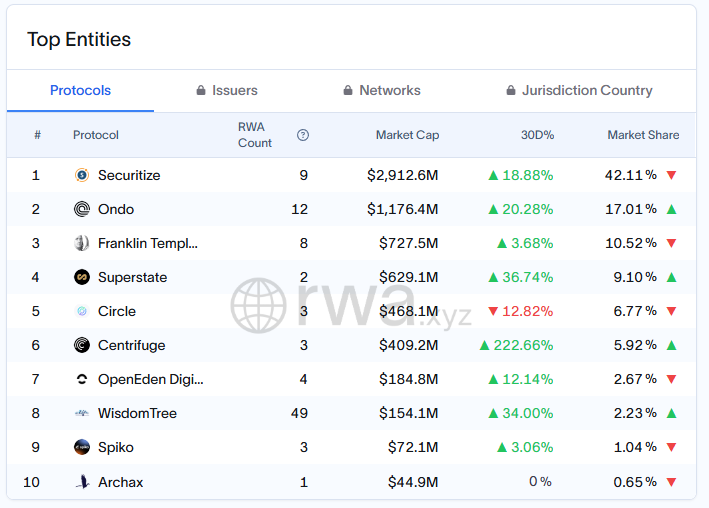
Data Source: https://app.rwa.xyz/treasuries
According to statistics from the RWA data platform RWA.xyz, as of May 2025, Ondo ranks second in the U.S. Treasury RWA market by locked assets, with a market share of approximately 17.01% and locked assets totaling about $1.17 billion. The first place is held by the Securitize platform, supported by BlackRock, with locked assets of approximately $2.91 billion and a market share of 42.11%. The third place is Franklin Templeton's Benji platform (approximately $727 million, 10.52%).
In the sub-market of Treasury yield tokens, Securitize and Ondo maintain a leading position, with Securitize having a larger asset scale, while Ondo's growth rate is also rapid (20.3% growth in the last 30 days). Centrifuge focuses on private credit RWA such as loans to small and medium-sized enterprises, with locked assets of approximately $409 million, accounting for 5.96%, and a staggering growth rate of 222.66% in just one month.
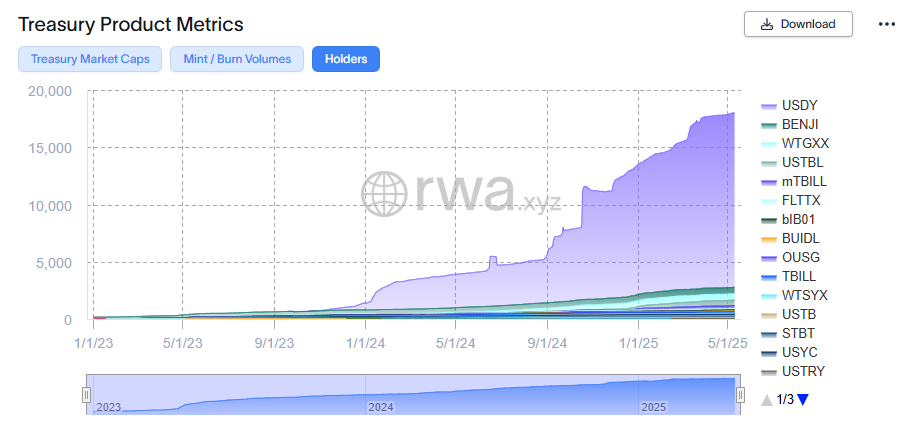
The number of holders of various Treasury tokenized assets, data source: https://app.rwa.xyz/treasuries
Notably, Ondo far outpaces other projects in terms of the number of holders—its U.S. Treasury token holders account for over 90% of the entire market (due to USDY being open to non-U.S. ordinary investors, resulting in a broad user base), while Securitize and others prefer to serve institutional investors, with holders primarily being a few large clients.
2.2 Product Positioning and Mechanism Differences
Ondo focuses on high liquidity, stable yield U.S. dollar assets (short-term Treasury bonds, money market funds) and aims to integrate them into DeFi applications, launching USDY as a "yield stablecoin" that can be used for payments and collateral. In contrast, Securitize, as a digital securities issuance platform, has a broader service scope, including the tokenization of private equity and fund shares. However, in the U.S. Treasury yield product space, Securitize has partnered with BlackRock to issue the BUIDL fund token (custodied through Coinbase), primarily targeting institutional and affluent clients. BUIDL and OUSG are both accumulation yield fund tokens, but their liquidity mechanisms differ: BUIDL typically only allows subscriptions and redemptions during specific hours on U.S. business days, while Ondo's OUSG offers year-round instant mint-and-burn services. In terms of DeFi integration, Ondo clearly has the upper hand—its USDY and OUSG are available in over 80 applications across multiple chains and support on-chain collateralized lending (Flux). In contrast, Securitize focuses on matching trades through its own licensed trading system (ATS license) and has not deeply integrated into public DeFi protocols, although it is regarded as an important underlying yield asset by many projects, including Ondo and Ethena.
Centrifuge's products are entirely different: its core is the Tinlake loan pool, which packages real-world assets such as factoring receivables and mortgage loans into coupon rights for sale, with investors taking on higher risks for higher returns (often annualized 5-10%+). These assets have longer durations and poor liquidity, relying on large institutions like MakerDAO to provide exit liquidity (since 2021, MakerDAO has listed the senior bond tokens from the Tinlake pools as RWA collateral, allowing asset holders to open Maker Vaults and lock in corresponding claims to borrow DAI at agreed rates). Accordingly, Centrifuge's governance token CFG is more used for on-chain staking and security guarantees rather than being positioned for everyday retail and payment scenarios, representing a more niche segment within RWA.
Polymesh is positioned as a dedicated securities chain, facilitating institutions in issuing various compliant tokens (stocks, bonds, fund shares, etc.) through built-in identity verification and permission controls. Polymesh evolved from the original Polymath project, with its POLYX token used for paying on-chain fees and governance, but actual asset issuance activities on the Polymesh network are still limited, with a scale far smaller than RWA activities on mainstream public chains like Ethereum. However, some heavyweight traditional institutions (such as WisdomTree) have chosen to collaborate with Ondo (issuing assets through Nexus and serving as design advisors for Ondo Chain) rather than building their own chains, indicating that Ondo has better prospects for business implementation in the long run.
2.3 Compliance and Regulatory Progress
In terms of compliance, each platform has adopted different strategies.
Ondo collaborates with regulated financial entities, following a "registration exemption + overseas issuance" model. The so-called registration exemption means that securities issued by institutions meet specific exemption criteria, such as not being open to the general public in the U.S., thus exempting them from public offering registration with the SEC, reducing compliance costs and improving issuance efficiency. OUSG is only open to qualified investors as private securities in the U.S., while USDY is issued overseas through foreign entities. Ondo's compliance team has a rich background, with its Chief Compliance Officer and several executives coming from Wall Street institutions like Goldman Sachs, making them familiar with regulatory rules.
Securitize, on the other hand, directly holds multiple U.S. financial licenses, including Broker-Dealer and SEC-registered transfer agent licenses, thus having more direct compliance authority when issuing digital securities. This enables it to legally provide services for large asset management plans, such as tokenizing KKR fund shares. At the same time, Securitize collaborates with several large banks to explore blockchain applications. In contrast, Ondo has not yet held an SEC license itself but operates legally through partner structures (such as collaborations with Clear Street broker-dealer and Coinbase custody). Globally, Ondo expands its market by utilizing regulatory arbitrage (not offering USDY to U.S. citizens), while Polymesh integrates compliance from the ground up (requiring each address to bind an identity). Centrifuge holds underlying assets through offshore special purpose vehicles (SPVs) and provides legal opinions to ensure that its tokenized claims do not violate securities laws.
Regulatory policy risk is a common challenge faced by all RWA platforms. If the U.S. were to require such tokens to be classified as public securities in the future, both Ondo and Securitize would need to obtain more comprehensive licenses or change their issuance methods.
However, at present, Ondo maintains good communication with regulatory agencies, such as choosing to establish a regulated subsidiary in the U.S. (Ondo I LP, etc.) and operating in accordance with existing rules, with products like USDY emphasizing daily transparency reports from independent third parties. This somewhat reduces the risk of enforcement actions. In contrast, attempts by some decentralized RWA projects (such as selling RWA tokens to U.S. users without registration) are more likely to become targets of regulatory crackdowns.
2.4 Ondo's Phase Advantages
Ondo's current advantage lies in the brand recognition brought by its extensive support from the traditional financial ecosystem. Through various product collaborations and public relations efforts, Ondo has "skillfully" gained indirect endorsements from financial giants such as BlackRock, Morgan Stanley, and Fidelity. For example, the Buidl issued by BlackRock is one of the underlying assets of OUSG; although there is no direct collaboration between the two, the extensive publicity led the market to regard Ondo as a major "BlackRock concept coin." Top asset management companies like Franklin and Wellington have directly participated in the Ondo Nexus program, contributing their U.S. Treasury products as part of the Ondo ecosystem. Even payment giants like PayPal and Mastercard have collaborated with Ondo—PayPal's PYUSD stablecoin will be used for OUSG redemptions, while Mastercard has invited Ondo to join its multi-token network (MTN) pilot, integrating bank payment interfaces into on-chain settlements.
Although the depth of these collaborations with many large institutions cannot be described as profound, compared to other RWA projects, these partnerships not only provide Ondo with excellent advertising effects and brand accumulation but also serve as demonstration cases for further commercial collaborations.
Overall, Ondo connects "both ends": upstream, it connects with traditional asset management giants to acquire assets and brand reputation; downstream, it connects with the crypto market to gain users and liquidity, striving to open the market faster than other projects.
3. Major Challenges and Risks
Despite Ondo's good progress, its business still faces multiple challenges and risks:
3.1 Intensified Competition
Ondo's phase advantage is more relative to other Web3 projects; compared to projects backed by large platform institutions (such as Securitize, which is invested in by BlackRock), Ondo's advantages are not obvious. Currently, due to unclear regulatory rules, many large financial institutions have not fully entered the fray. The source assets for RWA remain a stronghold of TradFi giants, and with such a large financial pie, they have ample motivation to build their own ecosystems to digest it rather than handing it all over to emerging Web3 projects like Ondo.
3.2 Product Delivery and Implementation Capability
Ondo's core protocols, such as Global Markets and Ondo Chain, have not yet been officially delivered; the current products are primarily asset-based, and its lending protocol is a fork of Compound V2, which is relatively simple. In the future, after the delivery of core products, whether Ondo can withstand tests across multiple dimensions such as product, operation, and compliance remains uncertain.
3.3 Uncertainty in Regulatory Compliance
Although the current U.S. government is the most crypto-friendly administration to date, no formal crypto regulatory legislation has been passed (the recent rejection of the stablecoin GENIUS Act is a microcosm of this), and 2026 will see midterm elections in both houses, with the Republican advantage in both houses remaining uncertain after the elections. If compliance legislation for asset tokenization cannot be passed before the midterm elections, subsequent progress will become more difficult, significantly increasing uncertainty.
3.4 Token Risks
- The current circulation rate of the Ondo token is only about 34%, facing a potential inflation rate of up to 64% in the coming year, leading to significant selling pressure.
- The value capture of the token is unclear; the current ONDO token primarily grants governance rights, with no clear fee-sharing or buyback-and-burn mechanism.
4. Valuation Reference
The total supply of ONDO is 10 billion tokens, with approximately 3.16 billion currently in circulation, accounting for about 31.6% of the total.
Based on today's price (May 11, 2025), Ondo's circulating market cap is approximately $3.27 billion, while the fully diluted market cap is about $10.3 billion.
Among similar asset tokens, ONDO far exceeds other projects in both circulating market cap and FDV.

From a relative valuation perspective, the market cap ratio of ONDO/CFG is about 40x, while the ratio of Ondo TVL/CFG TVL is about 2.7x, indicating that the price of ONDO has fully priced in optimistic expectations for future expansion, largely overextending the potential for future increases, making this market cap quite vulnerable in the face of various risk factors.
From a fundamental analysis standpoint, the current valuation of the ONDO token is still evidently high.
Starting from Ondo's static status: with a market cap of $3.27 billion, assuming Ondo's annual revenue primarily comes from management fees and interest spreads from USDY and OUSG (estimated based on an asset scale of $1 billion, average yield of 5%, and fee ratio of 0.3-0.5%), the annual revenue is approximately $3-5 million, plus miscellaneous income from Flux, estimating total annual revenue to be less than $10 million.
The static price-to-earnings ratio (P/E) calculated from this circulating market cap far exceeds 300 times, with FDV exceeding a thousand times, indicating that it appears very expensive based on traditional valuation, especially since the ONDO token does not have a clear value capture mechanism.
The current high valuation of the ONDO token reflects the market's extremely optimistic growth premium for Ondo's future over the next few years: if Ondo can expand to $10B+ TVL within 2-3 years (as suggested by the official "Next Stop: $10B" goal) and successfully extend its business into areas like equities, the revenue scale could increase by an order of magnitude, allowing the current valuation to be somewhat digested.
Ondo's high valuation also stems from its grand narrative of "On-chain Wall Street 2.0"; if Ondo Chain develops smoothly, Ondo could enjoy valuation levels similar to public chains, making a market cap of several billion dollars and an FDV of over $10 billion seem less exaggerated.
Of course, considering the numerous issues mentioned in the "Challenges and Risks" section, it takes a lot of effort, luck, and a favorable market atmosphere for a project to reach this stage, which carries significant uncertainty.
Key Events to Watch in the Future
The following events and data will directly impact the project's expectations and have a relatively direct effect on token prices, warranting close attention:
- Project Progress:
Deployment and launch of the Ondo Chain mainnet and testnet.
Testing and launch of Ondo Global Markets.
Whether to introduce and issue more new categories of RWA assets.
Whether to attract more institutional-level partners and deepen the currently relatively shallow collaborations with large financial institutions.
Whether asset scale continues to grow.
- Changes in the External Environment:
Legislative progress of the U.S. asset tokenization bill.
The SEC's regulatory stance on asset tokenization, whether it will clarify "sandbox-style regulation," meaning that business can be explored ahead of legislation.
Whether traditional TradFi giants will personally enter the market to build products and platforms, and whether the blue ocean will quickly turn red.
免责声明:本文章仅代表作者个人观点,不代表本平台的立场和观点。本文章仅供信息分享,不构成对任何人的任何投资建议。用户与作者之间的任何争议,与本平台无关。如网页中刊载的文章或图片涉及侵权,请提供相关的权利证明和身份证明发送邮件到support@aicoin.com,本平台相关工作人员将会进行核查。




